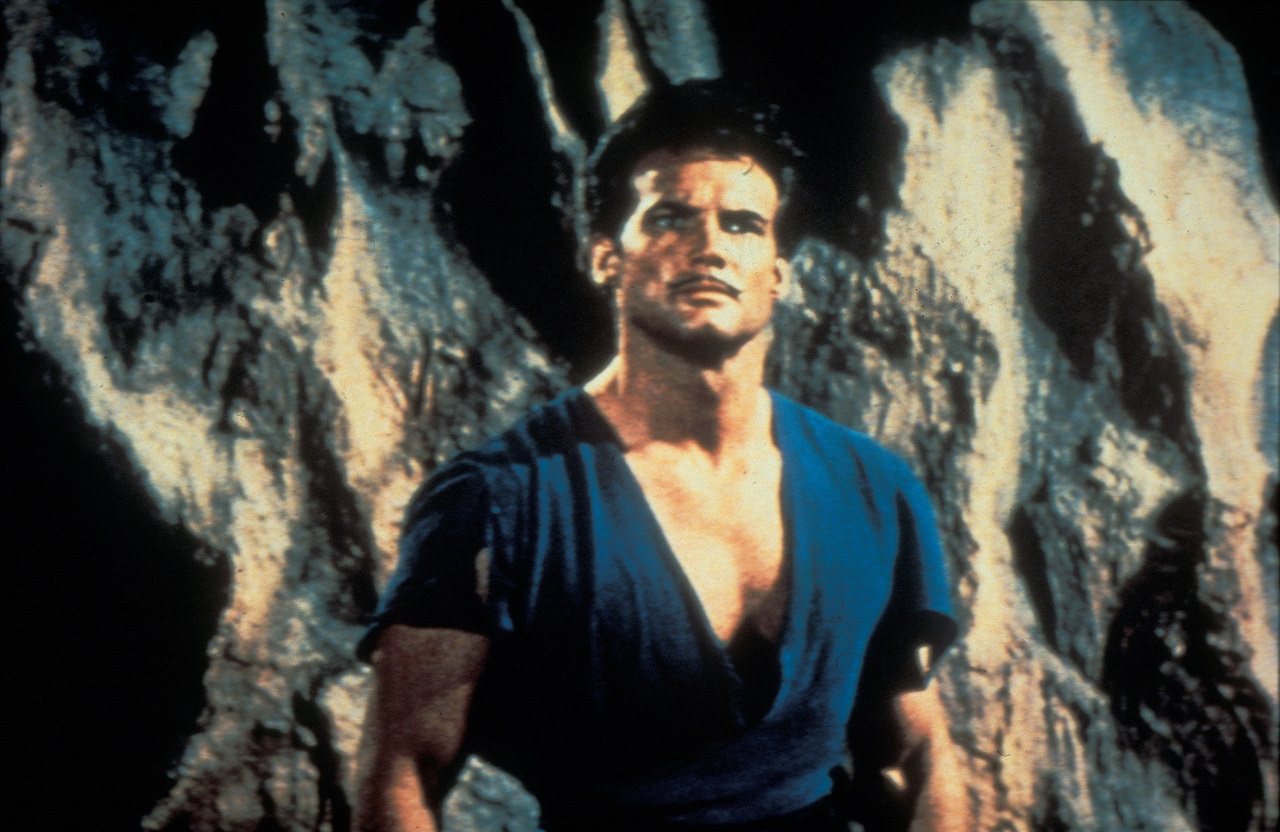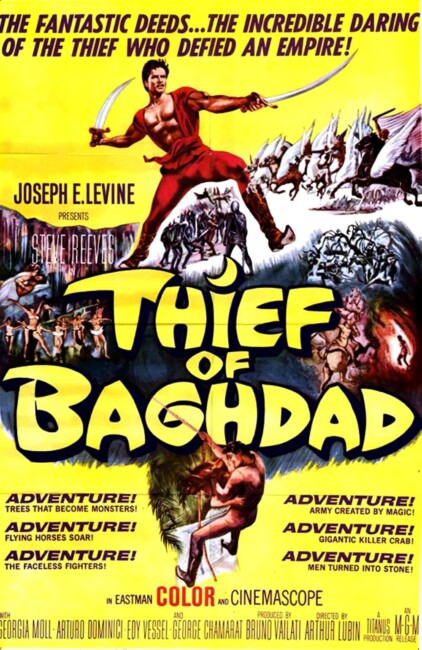(Il Ladro di Bagdad)
Italy. 1961.
Crew
Director – Arthur Lubin, Screenplay – Augusto Frasinetti, Filippo Sanjust & Bruno Vailati, Producer – Bruno Vailati, Photography – Tonino Delli Colli, Music – Carlo Rustichelli, Special Effects – Tom Howard, Art Direction – Flavio Morgherini. Production Company – Titanus S.P.A
Cast
Steve Reeves (Karim), Giorgia Moll (Princess Amina), Georges Chamarat (The Magician), Arturo Dominici (Prince Osman), Antonio Battistella (The Sultan), Daniele Vargas (Gamal), Edy Vessel (Kadigia), Luigi Visconti (Abdul)
Plot
The thief Karim daringly conducts a theft at a reception held by the Sultan of Baghdad for the visiting Prince Osman by posing as the prince. Fleeing, Karim hides in the room of the Sultan’s daughter Princess Amina and the two fall in love at first sight. However, the real Osman has come to ask the Sultan for Amina’s hand. When she rejects him, the Sultan’s devious Wazir goes to Osman, offering him a potion that will make Amina love him. But because Amina loves Karim, the potion causes her to fall ill instead. A mysterious magician announces that the solution to Amina’s illness is to find a blue rose. The Sultan decrees that a quest be held for the blue rose, with the successful questor becoming Amina’s husband and the sultan. Karim sets out, determined to be the one to win the princess’s hand.
The Thief of Baghdad is one of the more popular cinematic works of fantasy. Although it gives the appearance of being based on the Arabian Nights, The Thief of Baghdad is in fact is a story that is original to cinema. The story changes considerably between each different film version, with the only common elements being the thief and the generic Arabian Nights fantasy setting – see Arabian Nights Fantasy. The first two versions of the story, the silent Douglas Fairbanks The Thief of Bagdad (1924) and Alexander Korda’s lavish colour remake The Thief of Bagdad (1940) with Sabu, are epic fantasies, works whose overpowering sweep of imagination stand heads and shoulders above anything else of their era. There have been two further remakes, this Italian-produced version and the cinematically released tv movie The Thief of Baghdad (1978), both of which are dreary and impoverished of imagination.
This version was produced at the height of the Italian Peplum fad, more commonly known as the ‘sword-and-sandal’ cycle. The cycle had been begun with Hercules (1958) starring Steve Reeves. Independent US producer Joseph E. Levine brought up Hercules and pumped a great deal of money into promoting the film, making it a huge hit Stateside. This resulted in dozens of Italian-made adventure films with bodybuilders playing the parts of classic heroes such as Hercules, Samson and Ulysses. The Thief of Baghdad has been mounted in a clear attempt to emulate the success of Hercules and again unites Joseph E. Levine and Steve Reeves.
This version of The Thief of Baghdad is certainly made with a degree of lavishness. Joseph Levine and the Italians have clearly spent some money on it (much more than the other peplum) – there is an extravagance and a colour to the sets and costumes. The filmmakers also went on location in Tunisia – making this possibly the first Arabian Nights adventure to actually shoot in an Arabic country – and the authenticity of the Muslim architecture and peoples in the marketplace give the film a rare realism that the previous versions, which were all studio-bound, lacked. Steve Reeves even looks Arabic in features, although this is an illusion that is promptly shattered by his blue eyes.

The problem with the film is that, despite the lavishness afforded to it, it befalls director Arthur Lubin. Arthur Lubin was primarily a comedy director who had made a number of Abbott and Costello films, as well as directed the entire Francis the Talking Mule series begun with Francis (1950). Lubin had previously ventured into genre material with the Boris Karloff-Bela Lugosi mad scientist/brain transplant film Black Friday (1940); the Abbott and Costello Old Dark House comedy Hold That Ghost (1941); the dull colour remake of Phantom of the Opera (1943) with Claude Rains; a previous Arabian Nights adventure Ali Baba and the Forty Thieves (1944); the dull Greek myth drama Night in Paradise (1946); It Grows on Trees (1952), a comedy about trees that grow money; and The Incredible Mr Limpet (1964) wherein Don Rickles turns into a porpoise.
Despite a grounding in genre material, Arthur Lubin has a workmanlike pedestrianness of approach and resolutely refuses to allow the fantasy in the film here to fly in any way. An Arabian Nights film like The Thief of Baghdad should swashbuckle, it should delight with the dexterity of the sword battles, the magic of the flying carpets and genies but Lubin seems unable to direct action sequences. Instead, he throws in silly slapstick scenes with Steve Reeves running about the palace, fooling the guards into thinking he has run the other way. There is a sequence, mind-boggling in its witlessness, where Steve Reeves manages to make an escape from prison as a shooting star passes in the sky by fooling the guards into believing that shooting stars becomes pearls, then throwing a handful of pearls on the ground and slipping out while they are squabbling for them. The sequence is so moronically conceived that it defies belief.
Where the Douglas Fairbanks and Sabu versions of The Thief of Baghdad were swashbucklers, this version has clearly been made in the post-peplum era where Steve Reeves’s Thief is a muscle-builder – when he encounters a troll he ends up wrestling him rather than engaging in any sword duelling. Lubin mounts a moderately impressively scaled battle sequence at the climax but this is severely undercut by the silliness of the image of Steve Reeves running across the battlefield spanking the villain with a log.
What displays of magic there are in the piece are crude stop-action effects – a belt transforms into a snake, the old man appears to walk through a wall. We do finally arrive at some out-and-out fantasy sequences about two-thirds into the film – a forest of ambulatory trees (although the effects work on these is down around the level of the average 1970s episode of Doctor Who [1963-89]), pits of fire, a lost city with a seductive queen wanting to dull Steve Reeves’s wits and make him stay, an invisible cape and finally a Pegasus. Although these are colourful, Arthur Lubin almost seems to be engaged in an active conspiracy to wring as little imagination out of them as possible.
Trailer here


